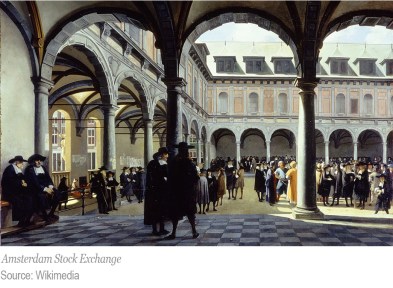
June 2022 marks the 250th anniversary of the outbreak of the 1772-3 credit crisis. Although not widely known today, this was arguably the first “modern” global financial crisis in terms of the role that private-sector credit and financial products played in it, in the paths of financial contagion that propagated the initial shock, and in the way authorities intervened to stabilize markets. In this post, we describe these developments and note the parallels with modern financial crises.
The Evolution of the Credit Crisis
The 1772-3 crisis was global in scope, with failures spread across Great Britain and the Netherlands, the other main European financial centers, and as far afield as St. Petersburg and the West Indian and North American colonies (as covered in a previous Liberty Street Economics post). Over the course of a year, it disrupted credit markets, adversely affecting both banks and non-bank borrowers.
There were two waves of failures. Sparked by the flight of the Scottish banker and speculator Alexander Fordyce, panic broke out on June 9, 1772, in London, with the experimental Ayr Bank in Scotland an important casualty soon after. Another round of failures hit Amsterdam over the winter of 1772-3; most notable among these was the ancient bank of Clifford, held by contemporaries to be the second most important bank in Europe.
Since the role of fast-changing private credit markets was crucial in precipitating and propagating the crisis, we start with an overview of the private credit instruments prevailing at the time.
Bills of Exchange Helped Transmit Contagion
The bill of exchange was the primary credit tool fueling trade in this era: a promise to pay money (usually foreign currency) in a defined place and at a certain time. It was effectively an IOU that a merchant or bank could “accept” or ask a third party with stronger credit to accept (underwrite) on its behalf. Depending on the distance that the bill or related shipments might need to travel, the bill would typically have a maturity of up to a year, though three-six months was more common.
Although originally created to support short-term trade, a bill could (and did) become endorsed to third parties as payment of debts before its maturity, in effect serving as a paper money surrogate. All parties (including endorsers) undersigning a bill were jointly and serially liable for the debt, thus diversifying credit risk in normal times. During times of distress, however, the bill’s credit liability characteristics served as an avenue of financial contagion since all undersigned parties were at equal risk to be called upon for the full debt.
The bill of exchange was also increasingly used in long-term finance by “rolling” an expiring bill with a matching bill on the same date, in a process known as swiveling. This helped merchants to secure working capital, but also allowed speculators to finance long-dated, higher-risk asset purchases, such as commodities or equities. The “rollover” risk inherent in this process is similar to that underlying the global financial crisis of 2007-9.
Mortgage Lending
Innovations in mortgage lending in the mid-eighteenth century stand out for their contributions to financial instability in the run-up to 1772 and the failures of that year. The mortgages themselves became more speculative as they included riskier loans, such as those collaterized by West Indian plantations managed on the behalf of absentee owners. As the loans were pooled and sold as mortgage-backed securities (MBS), they distributed the underlying risks to investors broadly.
MBS (negotiaties in Dutch) were issued on a massive scale in the Netherlands in the 1760s. They were sold to well-to-do retail investors, often in increments of 1,000 guilders, a sum about six to eight times the annual income of a typical citizen. The plantation sector in the Caribbean provided the fuel for the boom, with mortgages on Dutch and Danish plantations in the West Indies used as collateral for over 40 million guilders in new loans (or about 22 percent of the GDP of Holland) in the years 1766-72 alone. By the end of the decade, the volume of new loans exceeded the productive investment opportunities.
Margin Lending
Speculation in the stock markets, then as today, relied to a significant extent on margin lending. Notaries and other intermediaries had long used the pledge of securities as the basis for short-term loans. In the Amsterdam market, these loans were typically for six months, with an option for renewal should both parties consent. A haircut on the pledged securities helped to ensure that in case of a borrower default, there would be more than enough value in the collateral to cover losses.
This investing was often conducted cross-border, with the Dutch acting as major financiers of speculation in British shares and debt securities. Increasingly, sophisticated investors lent via arrangements similar to those used today by prime brokers when they lend to hedge funds. These lenders ensured that they could re-margin their loans in response to market movements and thus were able to avoid losses, even as a credit crisis gripped the market.
Not all lenders, however, showed this level of sophistication. Some lent against illiquid securities, such as negotiaties. Others failed to secure legal control of collateral, and disputes about who was entitled to what share of recovered creditor funds continued for many years afterward.
Cleaning Up the Mess
To quell the panic and to ensure that the commercial economy did not collapse, authorities employed tools familiar to modern readers: collateralized lending facilities and lender-of-last-resort powers.
In Amsterdam, civic authorities set up a collateralized lending facility open to anyone with qualifying collateral to pledge. Loans backed by various warehoused commodities (Beleningskamer loans), and provided at standardized advance rates, replaced some of the lending capacity that had been lost. While these loans were relatively modest in size, the very existence of the facility stopped the downward spiral of forced commodity liquidations and helped bring private lenders back into the market. These loans, combined with the arrival of precious metal shipments called in from other European financial centers, ensured that markets had resumed normal functions by mid-1773, although investors absorbed large losses.
The Bank of England provided last-resort lending starting in 1772 (although the term itself was not coined until three decades after the crisis). The Bank provided liquidity by increasing the volume of its discounts. Because of usury laws, the Bank was obliged to credit ration these loans instead of raising its discount rate as Bagehot would later suggest. But the Bank did not hesitate in deploying additional containment resources, such as supporting the biggest bill acceptors in London with targeted short-term loans, through which they, in turn, could support their clients.
Final Words
Intense as the twin panics of 1772-73 were, authorities were able to stabilize markets and restore confidence in the economy. These events resulted in a larger role for the institutional infrastructure of finance, focused around central banks and other state institutions, and created a set of financial stabilization techniques that are still in use today. The availability of these new tools was fortuitous, since Europe was entering the period of the most profound changes in economic growth and capital investment in human history.

Stein Berre is a director in the Federal Reserve Bank of New York’s Supervision Group.
Paul Kosmetatos is a lecturer in International Economic History at the University of Edinburgh.

Asani Sarkar is a financial research advisor in Non-Bank Financial Institution Studies in the Federal Reserve Bank of New York’s Research and Statistics Group.
Disclaimer
The views expressed in this post are those of the author(s) and do not necessarily reflect the position of the Federal Reserve Bank of New York or the Federal Reserve System. Any errors or omissions are the responsibility of the author(s).










 RSS Feed
RSS Feed Follow Liberty Street Economics
Follow Liberty Street Economics
Great article! Really interesting stuff!
Dear Authors, This was a most informative article that was a delight to read. I was not familiar with this story. It is my personal view that, in equal measure with the narrative disciplines, technical disciplines cannot be mastered without a deep knowledge of the history of that discipline. This then is doubly so with economics which is both a narrative discipline and a technical one. Please keep these coming.